Map Based Question
Q1) Consider the following statements
- Anatolian Block lies to at the tri junction of Eurasian, African and Arabian plate
- 2. Istanbul lies on the coast of Aegean Sea.
Which of the above statements is/are correct?
a.) 1 and 2 only
b.) 1 only
c.) 1 and 3 only
d.) 2 only
From Our Test Series
Q2) Consider the following statements regarding the P-waves and S-waves:
- P-wave is a body wave and S-wave is surface wave.
- Speed of P-wave is higher than that of the S-wave.
- P-wave can travel through gaseous, liquid and solid materials while S-wave can only pass through solid materials.
- P-waves vibrate parallel to the direction of the wave while vibrations of S-waves are perpendicular to the wave direction in the vertical plane.
Which of the statements given above is/are correct?
a.) 1, 2 and 3 only
b.) 2, 3 and 4 only
c.) 1 and 3 only
d.) 1, 2, 3 and 4
Q3) Consider the following
- Eurasian Plate
- Pacific Plate
- Cocos Plate
- Nazca Plate
Which of the following is/are NOT major plates ?
a.) 1 and 3 only
b.) 2 and 4 only
c.) 4 only
d.) 3 and 4 only
Q4) Which of the following are associated with Ring of Fire :
- Transform Plate Boundary: San Andreas Fault
- Convergent Plate Boundary : Aleutian Trench & Andes Mountain
- Divergent Plate Boundary : East Pacific Rise
a.) Only 1
b.) Only 2
c.) Only 3
d.) All of the above
Answers with Explanations
Map Based Question
Q1) Consider the following statements
- Anatolian Block lies to at the tri junction of Eurasian, African and Arabian plate
- Istanbul lies on the coast of Aegean Sea.
Which of the above statements is/are correct?
a.) 1 and 2 only
b.) 1 only
c.) 1 and 3 only
d.) 2 only
Plate Movement
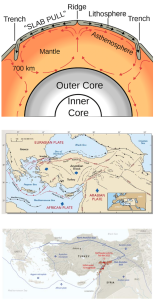
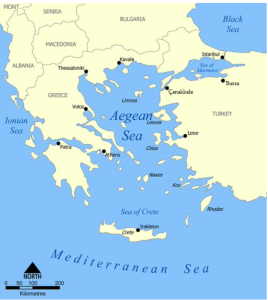
- This latest earthquake is likely to have happened on one of the major faults that marks the boundaries between the Anatolian and Arabian plates: either the East Anatolian fault or the Dead Sea Transform fault.
- These are both “strike-slip faults”, which means they accommodate some motion of plates moving past each other.
- Severe to violent shaking (enough to cause significant property damage) is estimated to have been felt by 610,000 people in the surrounding area up to around 80 kilometers away north-eastwards along the tectonic plate boundary. Light shaking was felt as far away as Turkey’s largest city Istanbul (around 815 kilometers away), as well as Baghdad in Iraq (800 kilometers) and Cairo in Egypt (950 kilometers).
- After major earthquakes there will be many smaller earthquakes known as aftershocks as the crust readjusts to the changes in stress. These can continue for days to years after the initial event.
- Strike-slip fault – a fault on which the two blocks slide past one another. The San Andreas Fault is an example of a right lateral fault.
From Our Test Series
Q2) Consider the following statements regarding the P-waves and S-waves:
- P-wave is a body wave and S-wave is surface wave.
- Speed of P-wave is higher than that of the S-wave.
- P-wave can travel through gaseous, liquid and solid materials while S-wave can only pass through solid materials.
- P-waves vibrate parallel to the direction of the wave while vibrations of S-waves are perpendicular to the wave direction in the vertical plane.
Which of the statements given above is/are correct?
a.) 1, 2 and 3 only
b.) 2, 3 and 4 only
c.) 1 and 3 only
d.) 1, 2, 3 and 4
- Earthquake waves are basically of two types — body waves and surface waves. Body waves are generated due to the release of energy at the focus and move in all directions travelling through the body of the earth.
Statement 1 is incorrect.
- The body waves interact with the surface rocks and generate new set of waves called surface waves. These waves move along the surface.There are two types of body waves. They are called P and S-waves.
Statement 2 is correct.
- P-waves move faster than the S-waves and are the first to arrive at the surface. These are also called ‘primary waves’. The P-waves are similar to sound waves.
Statement 3 is correct.
- P-waves can travel through gaseous, liquid and solid materials. S-waves arrive at the surface with some time lag. These are called secondary waves. An important fact about S-waves is that they can travel only through solid materials.
Statement 4 is correct.
- P-waves vibrate parallel to the direction of the wave. This exerts pressure on the material in the direction of the propagation. As a result, it creates density differences in the material leading to stretching and squeezing of the material. Other three waves vibrate perpendicular to the direction of propagation. The direction of vibrations of S-waves is perpendicular to the wave direction in the vertical plane. Hence, they create troughs and crests in the material through which they pass.
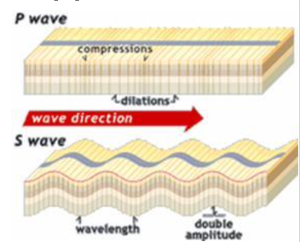
Q3) Consider the following
- Eurasian Plate
- Pacific Plate
- Cocos Plate
- Nazca Plate
Which of the following is/are NOT major plates ?
a.) 1 and 3 only
b.) 2 and 4 only
c.) 4 only
d.) 3 and 4 only
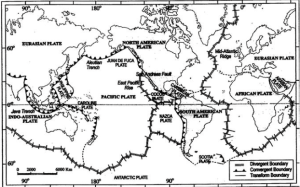
The Major and Minor Plates
The Earth’s lithosphere is divided into seven major and some minor plates.
These include:
The Antarctic (and the surrounding oceanic) plate
The North American plate (with western Atlantic floor separated from the South American plate along the Caribbean islands)
The South American plate (with western Atlantic floor separated from the North American plate along the Caribbean islands)
The Pacific plate
The India-Australia-New Zealand plate
The Africa with the eastern Atlantic floor plate
Eurasia and the adjacent oceanic plate
The Major and Minor Plates
Some important minor plates include:
Cocos plate: Between Central America and Pacific plate
Nazca plate: Between South America and Pacific plate
Arabian plate: Mostly the Saudi Arabian landmass
Philippine plate: Between the Asiatic and Pacific plate
Caroline plate: Between the Philippine and Indian plate (North of New Guinea)
Fuji plate: North-east of Australia
Juan De Fuca plate: South-East of North American Plate
Q4) Which of the following are associated with Ring of Fire :
- Transform Plate Boundary: San Andreas Fault
- Convergent Plate Boundary : Aleutian Trench & Andes Mountain
- Divergent Plate Boundary : East Pacific Rise
a.) Only 1
b.) Only 2
c.) Only 3
d.) All of the above
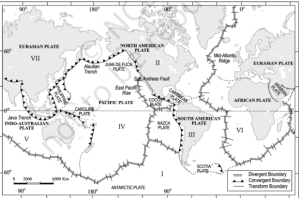
- Convergent Plate Boundary : Pacific Plate and North American Plate converge where pacific plate subducts under North Americal plate – This convergent plate boundary continues to form Aleutian islands (Hosts 27 Active Volcanoes)and Aleutian Trench.
- Nazca Plate and South American Plate converge where Nazca plate subducts beneath the South American tectonic plate. This convergence created Andes Mountain and Peru-Chile trench.
- Divergent Plate Boundary : In the ring of fire, East Pacific Rise (located on the divergent boundary of the Pacific Plate and the Cocos Plate) is a site of major seafloor spreading site.
- Transform Plate Boundary – One of the most active faults in the ring of fire is San Andreas Fault
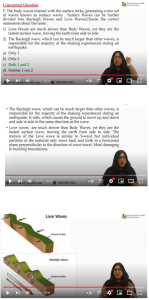
➡️UPSC 2023 General Studies Course: https://sleepyclasses.com/general-studies-for-upsc/
➡️Sociology Optional for UPSC : https://sleepyclasses.com/sociology-for-upsc/
➡️Political Science and IR for UPSC: https://sleepyclasses.com/psir-for-upsc/
➡️Signup here – https://sleepyclasses.com/
Have any query related to UPSC preparation: 📞Contact Us ► Toll-Free: 1800 890 3043 ► Mobile: 6280133177 ► Email: Sleepy.Classes@gmail.com ► WhatsApp: 6280133177



